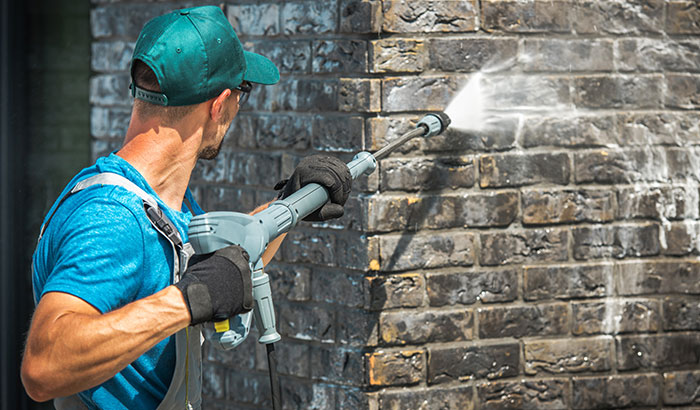Walls are easy to overlook, but washing your walls is essential for keeping a clean-feeling space. But don’t worry! It’s simple if you know the proper technique.
While washing your walls isn’t necessary every week, you should have some regularity in your routine to keep them looking fresh and avoid the buildup of grime. Dusting the corners may be a good thing to do weekly or biweekly to eliminate cobwebs and everyday dust.
A complete washing, you may only need to do semiannually for most of your home or office. More often may be advisable in kitchen areas where splatters are expected or in restrooms where moisture may create a favorable condition for mold and mildew.
Here is our seven-step process for washing your walls like a pro.
1. What’s Your Wall Covering?
This is probably the most critical part of wall cleaning because it affects your cleaning solution and the tools.
- Latex paint – Use a gentle cleaner like dish soap in warm water. Adding a small amount of distilled white vinegar can also help. Use microfiber cloths or sponges to wash and rinse.
- Oil-based paint – Similar to latex, but avoid vinegar. Acid can sometimes dull and damage the oil finish.
- Flat finishes – These surfaces can be finicky. They tend to hold onto stains more and are more susceptible to losing paint with heavy scrubbing. Use a gentle cleaning solution – mild dish soap and water works great.
- Gloss finishes are easy to clean because they are durable and less porous than other finishes. For this job, you can use a degreaser to approach areas like the kitchen, where the walls tend to be a little dirtier.
- Wood paneling – For this, avoid using too much water; a damp cloth with some dish soap is great. Also, remember to rub with the wood grain to avoid scratches.
- Wallpaper – A little dish soap in water is, again, a good option. Distilled vinegar can also be used. If the wall is pretty clean, you can spot clean using a little wallpaper dough. This is a good option for older wallpaper that doesn’t take moisture well.
2. Cover Your Floors.
This protects them from drips of cleaning solution, water, and dust that you’ll be disturbing. You can use a drop cloth or tarp if you have one available. A towel or garbage bag with the sides cut and splayed open works fine too.
3. Dust.
Before you can get to actually washing your walls, start by removing the easy stuff like dust and cobwebs. Otherwise, they can become grime that will get your cleaning solution dirty prematurely. To do this, you can use a soft-bristled broom or a duster. You can do this pretty quickly, focusing on the corners with the ceiling and the floor.
4. Spot Rest.
While the cleaning solutions we’ve recommended for different kinds of wall finishes should be safe for the respective covering, it’s always wise to test it in an obscure corner where people won’t notice if any discoloring happens.
5. Get Your Equipment Set Up.
For most wall coverings, you’ll need the following equipment:
- Two buckets, one for cleaning solution and one for rinse water.
- Your cleaning solution mix-in of choice. Remember our advice based on the type of finish on your walls.
- A sponge or washcloth for washing, another for rinsing, and a microfiber towel for drying.
- Some kind of drop cloth. It shouldn’t need to cover more than five or six feet at a time. Be sure and clear the wall you’ll be washing before you get started so you won’t have to stop in between so much.
- Additional solvents for stain cleaning as needed.
For the most part, you’ll work in small sections. Start at the top and work down. Before your cleaning solution is dry, rinse it, and then dry it with a cloth.
6. Wipe Down Your Walls, Ceiling To Floor.
And yes, we do mean start at the top and work down. This allows you to catch any drips from above as you’re cleaning lower later on. Go over it once with your cleaning solution, and then rinse it with your pure water while it’s still wet. Finally, dry it with a microfiber cloth.
Whether washing or rinsing, avoid getting your cloth or sponge dripping wet. Most of the time, it’s better just to have it damp. This is especially true around outlet covers and switch plates. If you are worried about this, it may be a good idea to turn off power to these outlets and switches – as long as you have enough natural light or other sources to see properly.
7. Tackle Tough Stains.
Watch for stains and other stubborn buildup that don’t come off readily as you go over your walls while washing and rinsing. You may need just to spend a little more time scrubbing or use a stronger solvent.
If that doesn’t get the job done, you may need to bring in a special agent. In general, Mr. Clean Magic Erasers and Goof Off are good options for many kinds of stains. Make sure you aren’t rubbing a scuff mark into your wall. Again, do a spot test before using one of these products in a prominent place.
- For permanent marker – try a little rubbing alcohol, aerosol hairspray, or white toothpaste. Rub gently, or you may take off some paint.
- Builtup grease – This often occurs on walls near stoves. Mineral spirits on a cloth should do the job quite nicely if you have wood paneling. Otherwise, make a paste out of baking soda and water. Gently rub that on your walls until you’ve removed the grease.
Rather Not Clean Walls Yourself? Let Town & Country Office Cleaning Help.
Washing your walls is a time-consuming process that you and your staff may not be super efficient at since it isn’t your regular responsibility. We are efficient at it and will do an excellent job for you.
Whether you’re in a typical office building that just needs lightly weekly cleaning with occasional deep cleans, or you have more rigorous cleaning requirements, we can help. We’re thorough, and we can be flexible around your schedule.
If your place of business is in the greater San Francisco Bay area, we’re the right cleaning service for you. Contact us to start your free estimate today.

